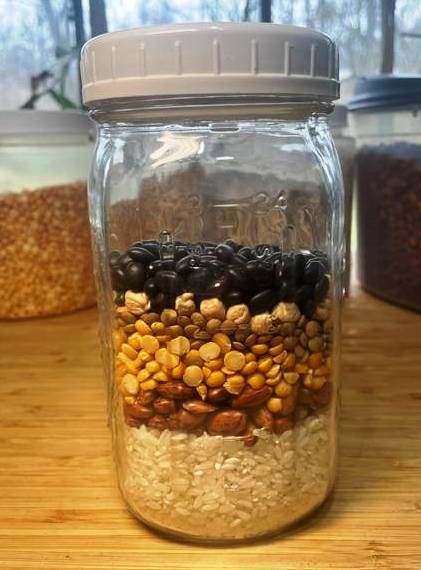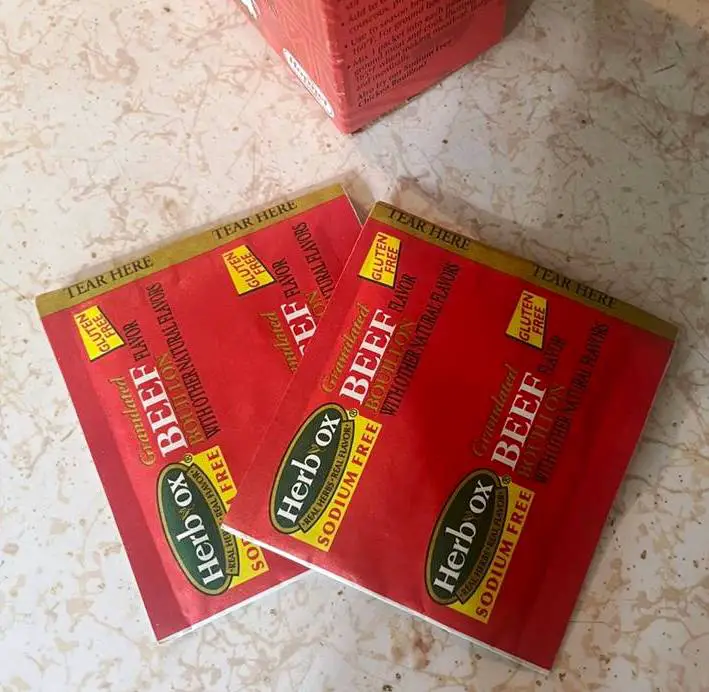Estimated reading time: 6 minutes
Prepackaged, freeze-dried foods are great for long-term storage, but the expenses can add up quickly. A large family like mine could easily burn through a few pricey pails of prepper food in no time! But not all preps have to be expensive, and one of the most cost-effective and simple ways to store food for your family is to make survival soup.
Want to save this post for later? Click Here to Pin It On Pinterest!
What Is Survival Soup?

Survival soup is a very basic soup that you can put together in jars, buckets, or mylar bags and keep in long-term storage. The base ingredients include rice and beans. These are stored dry until you are ready to use them.
The beauty of survival soup is that it is inexpensive to create, easy to store, and has a pretty unlimited shelf-life when stored properly. You can make plenty of variations based on the ingredients you have on hand, whether fresh or stored. This can help prevent appetite fatigue because you can serve it in so many different ways.
Beans are a healthy source of protein and calories, which you’ll need in a survival situation. Here’s how I made mine.
Ingredients for Survival Soup Base:

- 8 oz (1 cup) of rice
- 2 oz (1/4 cup) of red kidney beans
- 2 oz (1/4 cup of lentils
- 2 oz (1/4 cup) of split green beans
- 2 oz (1/4 cup) of chickpeas/garbanzo beans
- 2 oz (1/4 cup) of black beans
- 8 cups of water
- 5 packets of beef bouillon
Directions to Create Soup Base:
- Gather ingredients.
- Layer the ingredients in mason jars or mylar bags.
- Seal and label.

How to Cook Survival Soup:
- Rinse your beans and rice well in the mason jar until water runs clear.
- You may want to soak your beans overnight for faster cooking. This is critical in an actual survival situation where cooking fuel might be in short supply. However, soaking rice for long periods of time can lead to bacteria growth. If this is a concern, you may want to store your rice and beans separately.
- Add soup base and 8 cups of water to a large pot.

- Simmer until beans and rice are tender. Stir often and add water as needed. It took about 3 hours for my beans to soften.

- Add any additional ingredients and simmer for another half hour or until everything is cooked and tender. I added five packets of beef bouillon to my soup, which gave it a mild flavor.

- Serve and enjoy!

What to Add to Your Survival Soup
One of the greatest parts of survival soup is that it is incredibly versatile, so you can tailor it to whatever ingredients you have on hand, both fresh and stored. Here are a few examples:
Survival Soup Chili
Simmer your soup with some browned ground beef or turkey and chili seasonings to make a hearty chili stew that you can eat alone, with baked potatoes, or in tacos.
Survival Soup Variations
You can mix in several packets of beef or chicken bouillonor broth to add flavor and eat the stew as is.
Vegetable Survival Soup
Use your survival soup as a base and simmer some fresh vegetables from your garden or freeze-dried, frozen, or dehydrated vegetables from storage. They’ll add flavor and nutrients to a hearty soup base.
Survival Stew
You can add any leftover (pre-cooked) meat to your pot and simmer for at least half an hour. Leftover bits of ham, turkey, or beef make a tasty addition. You could also use freeze-dried meat or beef jerky to supplement your survival stew. Soak your hardtack or stale (but still edible) rolls or bread or crackers in your survival soup to add more calories to it.
You can adjust the ratio of beans to rice depending on what you have on hand and what your family’s preferences are. You can also use pearl barley, but you’ll want to store the barley separately.
This recipe made a large pot of survival soup that would feed my family of 6 for about two large meals.
You could package the soup in smaller quantities for smaller families or in larger amounts. If desired, you could fill a 5-gallonfood-grade bucket with your mixture of rice and beans. Add in a few oxygen absorbers,and as long as the beans stay cool and dry, they will keep for years. You can use them as needed.
Another way to preserve your dry survival soup is to vacuum seal the dry ingredients in mylar bags. Label the bags with the ingredients, date, and cooking directions. Small packages of survival soup are lightweight and easy to pack in a bug-out bag or take camping.
Like this post? Don't Forget to Pin It On Pinterest!

Survival Soup
Equipment
- 1 Soup pot or crockpot
Ingredients
- 1 cup rice
- 1/4 cup red kidney beans
- 1/4 cup lentils
- 1/4 cup green split peas
- 1/4 cup chickpeas/garbanzo beans
- 1/4 cup black beans
Instructions
- DIRECTIONS TO CREATE SOUP BASE:
- Gather ingredients
- Layer the ingredients in Mason jars or Mylar bags
- Seal and Label
How to Cook Survival Soup
- Rinse your beans and rice well in the Maso njar until water runs clear.
- You may want to soak your beans overnight for faster cooking. This is critical in an actual survival situation where cooking fuel might be in short supply. However, soaking rice for long periods of time can lead to bacterial growth. If this is a concern, you may want to store your rice and beans separately.
- Add soup base and 8 cups of water to a large pot.
- Simmer until beans and rice are tender. Stir often and add water as needed. It took about 3 hours for my beans to soften.
- Add any additional ingredients and simmer for another half hour or until everything is cooked and tender. I added five packets of beef bouillon to my soup, which gave it a mild flavor.
- Serve and enjoy!
Survival Soup Chili
- Simmer your soup with some browned ground beef or turkey and chili seasonings to make a hearty chili stew that you can eat alone, with baked potatoes, or in tacos.
Survival Soup Variations
- You can mix in several packets of beef or chicken bouillon or broth to add flavor and eat the stew as is.
Vegetable Survival Soup
- Use your survival soup as a base and simmer some fresh vegetables from your garden or freeze-dried, frozen, or dehydrated vegetables from storage. They’ll add flavor and nutrients to a hearty soup base.
Survival Stew
- You can add any left over (pre-cooked) meat to your pot and simmer for at least half an hour. Leftover bits of ham, turkey, or beef make a tasty addition. You could also use freeze-dried meat or beef jerky to supplement your survival stew. Soak your hardtack or stale (but still edible) rolls; bread or crackers in your survival soup to add more calories to it.
Storage
- To preserve your dry survival soup,vacuum seal the dry ingredients in Mylar bags. Label the bags with the ingredients, date, and cooking directions. Small packages of survival soup are lightweight and easy to pack in a bug-out bag or take camping.
You May Also Like:












